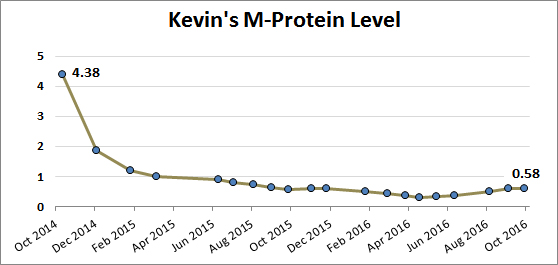Short version: I’m fine. Longer version: I just saw my oncologist, and he’s pretty satisfied with everything. My M-protein level—the primary measure of cancerous plasma cells in my bone marrow—has been sneaking upward for the past few months, but in October it plateaued at the same level as September. Here’s a special expanded version of my usual M-protein chart:

I started out at 4.38 when I was first diagnosed with multiple myeloma, and the initial chemotherapy got that down to about 1.0. The maintenance meds got it down to 0.3, but after we halted the evil dex1 it drifted up to 0.58. Higher is worse, but as you can tell from the chart, the entire past year has been fairly stable, and the minor ups and downs don’t mean a lot. An M-protein level of 0.58 grams is roughly equivalent to a cancer load of about 3-4 percent, and my body can tolerate that basically forever. Eventually my M-protein level will rise above 1.0 or so, and then it will be time to switch to a second-line med.
However, my oncologist’s satisfaction was mostly based on other stuff that I don’t usually write about. There are three types of plasma cells: G, A, and M.2 My cancer happens to be of the G cells. However, my A-type cells have increased quite a bit over the past few months, and apparently that’s an indication that my immune system is returning to normal. So that’s good. Also, my Kappa light chains are pretty low, and my Kappa/Lambda ratio is nice and stable.3 That’s also good. Put it all together and I’m in pretty stable shape.
However, the med I’m taking now can produce rashes in some people. It turns out I’m one of them. In my case, they’re little red dots that showed up on my lower legs last week, then spread to my upper legs, and are now invading my stomach. How far will they go? Beats me. But if they go much further, they’ll invade my face and I’ll look like I have a permanent case of the measles. Oh well.
1That’s dexamethasone, a corticosteroid that helps fight multiple myeloma. However, it has bad long-term side effects, so it can only be used for a few months at a time.
2This is not precisely the right terminology, but it’s close enough.
3For the record, I have IgG Kappa light chain multiple myeloma.

















